How farmers can reduce risk on train level crossings
Fears of a fatal accident – even when proper safety procedures are followed – have prompted warnings for farmers to take extra care when using unmanned railway crossings.
Concern is focused on so-called “user-worked level crossings” on private farmland, where a person wanting to get to the other side of the railway line has to phone for permission and operate two gates themselves before walking or driving across the track.
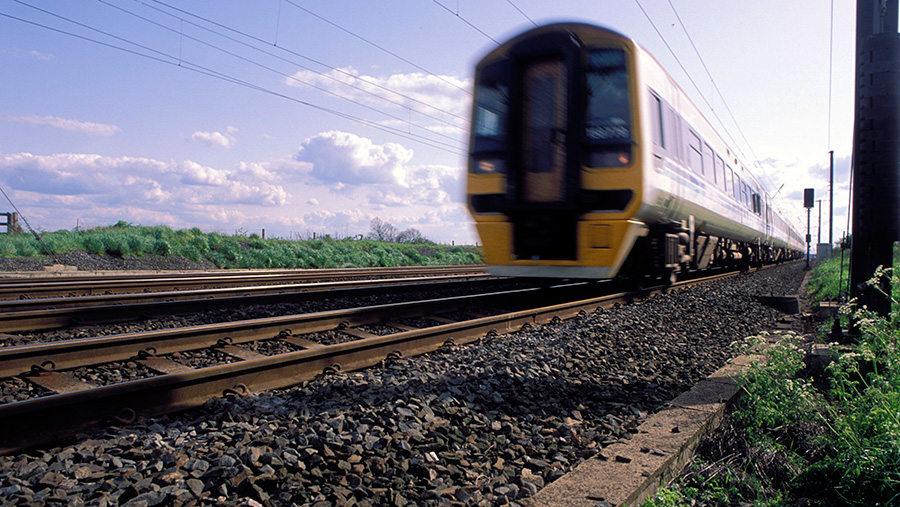
© Photofusion/REX/Shutterstock
Some 2000 of the UK’s level crossings are user-worked.
Because gates either side have to be opened and closed by hand, driving a vehicle to the other side can involve a person crossing the track five times in the process of getting over the line.
Two accidents within the past 18 months have served as stark reminders of the dangers associated with user-worked crossings.
See also: Farmers ‘dicing with death’ on level crossings
How to use a user-working level crossing
- Stop, look both ways and listen to make sure a train is not coming. If a train is coming, wait in a safe place
- You must use the telephone to get permission to cross if crossing with vehicles or animals
- When you have permission to cross, open the gates on both side of the railway
- Cross quickly and stay alert – do not stop on the crossing
- Close both gates after crossing, never leave them open
- You must telephone railway staff after crossing if the ask you to do so
(Source: Network Rail)
Although no-one was killed in either incident, tractor drivers in both instances were lucky to escape with their lives (see ‘Tractor driver hit by train had permission to cross line’ and ‘Network Rail failed to minimise risk at crossing’, below).
Others aren’t always so fortunate.
Two fatalities a year
Although user-worked crossings account for one in three level crossings and are often infrequently used, they account for more than half of all recorded near-misses between trains and vehicles – and two fatalities every year.
The need to minimise risks when using farmland level crossings topped the agenda at a meeting of railway and farm safety representatives last month at Cannock Chase, Staffordshire.
The event was organised by the Institution of Occupational Safety and Health (IOSH).
“The problem we’ve had is getting the message across about the significant risk [these crossings pose] to farmers, farmworkers and rail users,” says Alan Plom, vice-chairman of the IOSH rural industries group and a Farm Safety Partnership board member.
“The perception is often that a farmer can nip across quickly – there is a belief that a train is far enough away but often it is coming at full speed, says Mr Plom.
“It is a sudden shock when they realise the risk they are facing.”
Victorian design
Part of the problem is that the crossings were designed in the Victorian era, says Mr Plom.
Today, trains are faster and farm machinery bigger.
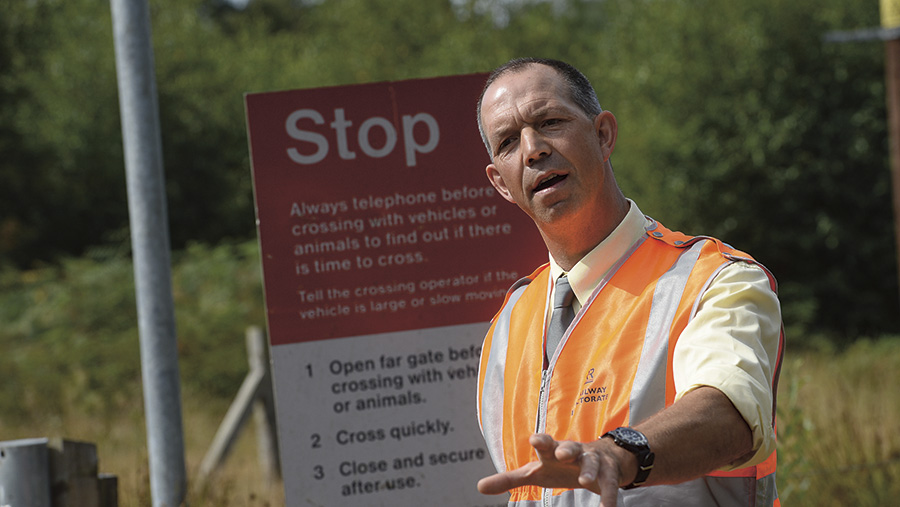
Adam Meredith, HM inspector of railways at the Office of Rail and Road says there is always and element of ‘residual risk’ at user-operated railways crossings © Steve Burden
“When you’re sitting in a farm vehicle, your bonnet is so long there is no way you can see up the track, so the risk is magnified straight away.”
Adam Meredith, senior engineer and HM inspector of railways at the regulator the Office of Rail and Road (ORR), says user-worked crossings are “safe if you follow the instructions at the crossing”.
But the risk that they pose often goes below the radar, he adds.
“While you can say there are instructions to follow – and that is what you must do for the safety of yourself and the train – clearly there is an element of residual risk in crossing the railway at one of these crossings,” explains Mr Meredith.
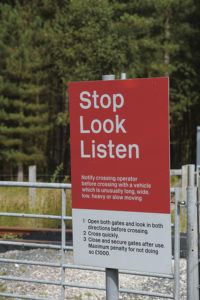
Farmers are advised to carry out a risk assessment before using railway crossings © Steve Burden
For this reason, user-worked crossings should be permanently closed in situations where a farmer can do without it or can take a diversionary route – even if doing so adds a couple of miles to the journey, says Mr Meredith.
Risk assessment
In cases where having a crossing is deemed necessary, farmers should ensure that employees undertake sufficient pre-planning and carry out a full risk assessment before starting any work which requires access to a user-worked crossing.
Mr Meredith says: “If I was crossing this regularly, I would ask what are the characteristics of this crossing, and what does the signaller know about it? Your safety management system needs to identify who is at risk, check what controls are in place and what can you do to ensure safety.”
Farmers who haven’t done so should call Network Rail, which owns and manages the railway network, and ask for a joint risk assessment of any user-worked level crossing on their land.
Such an inspection can result in the implementation of additional safety measures.
Network Rail says it is investing £100m to improve level crossing safety.
More than 930 level crossings have been closed since 2010, sometimes replaced with bridges or underpasses.
It has also teamed up with the NFU in a safety campaign aimed at farmers.
The campaign seeks to remind farmers to use trackside telephones to call the signaller before crossing the line.
Network Rail also provided farms with instructional booklets designed to be understood by farmworkers whatever their nationality or first language.
“Level crossings can be confusing to people who aren’t used to using them, but by following a few simple rules people can learn how to cross them with safety and confidence,” says Network Rail level crossing manager Robert Havercroft.
Tractor driver hit by train had permission to cross line
A tractor driver was lucky to survive after his vehicle was hit by a train travelling at 84mph – despite being given permission to cross the line near Thetford, Norfolk.
The 31-year-old man was seriously injured when a train travelling from Norwich to Cambridge collided with his tractor and trailer at Hockham Road level crossing at 12.30pm on Sunday 10 April.
The tractor was destroyed, and the train badly damaged.
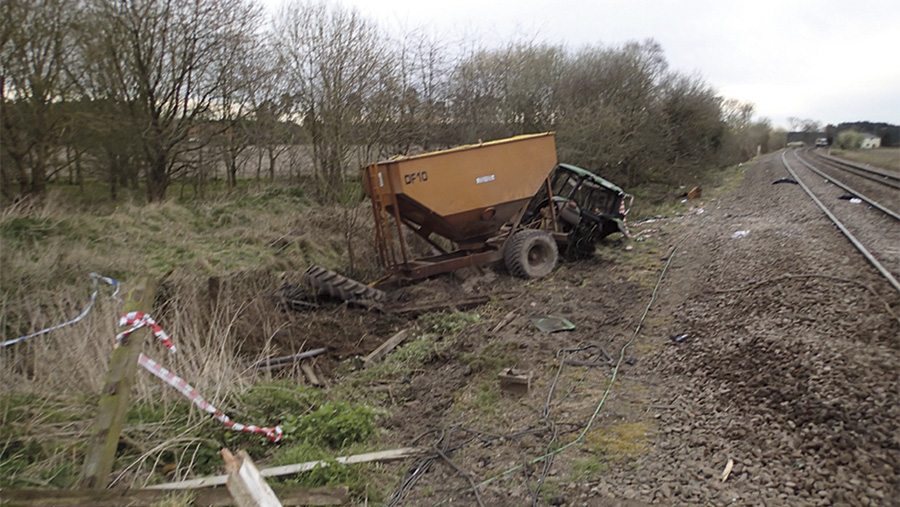
A 31-year-old was injured after a train collided with a tractor and trailer near Thetford, Norfolk © Rail Accident Investigation Board
An ongoing inquiry by the Rail Accident Investigation Board (RAIB) has already confirmed the tractor driver used a trackside phone and received the all-clear from the signaller to cross the line.
The tractor was at the mid-point of the crossing when it was struck by the train.
During the collision, the trailer separated from the tractor and struck the side of the train several times, breaking windows and puncturing the outer body of the train, before it came to rest next to the tractor at the side of the railway line.
The train came to a stop 410m beyond the crossing.
The train cab was severely deformed by the impact, and the driver’s door broke away.
The tractor driver was taken to hospital. The train driver and some of the 135 passengers sustained minor injuries.
The RAIB investigation is now seeking to identify the sequence of events that led to the accident.
It is also considering the method of authorising vehicles to use the crossing and any other factors which may have influenced the actions of the people involved.
Network Rail failed to minimise risk at crossing
Rail bosses were ordered to review gate opening equipment after a New Holland tractor was sliced in two when it was hit by by passenger train carrying 66 people.
The 5.29pm Leeds to York train collided with the front left-hand wheel of the tractor, causing the cab to separate from the rear of the vehicle.
The wheel was torn off and later found wedged under the front of the train after it stopped nearly 500m beyond the crossing.
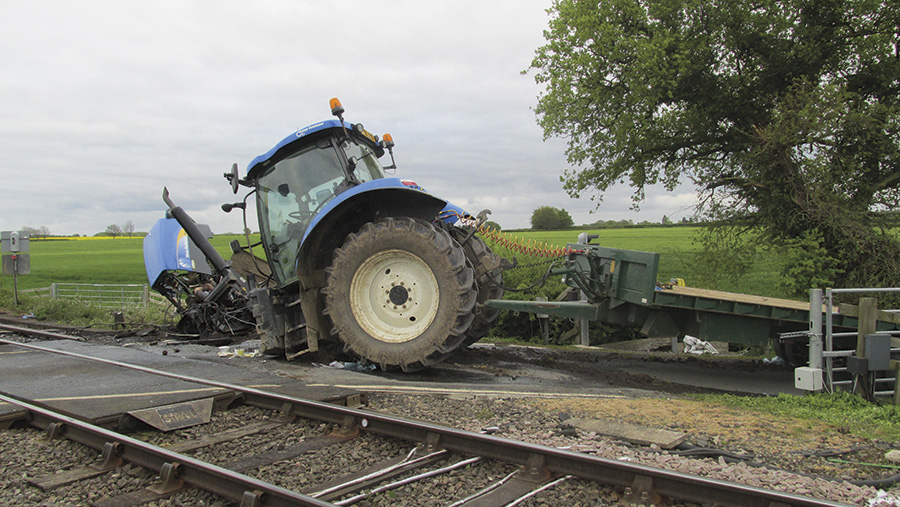
A train collision at Oakwood Farm’s user-worked level crossing in north Yorkshire which saw a New Holland tractor split in two led to a review of gate-opening equipment © British Transport Police
The incident happened at Oakwood Farm user-worked level crossing near Knaresborough, north Yorkshire on 14 May 2015.
Despite the carnage, the tractor driver escaped with minor injuries. The driver of the train, which was travelling at 65mph, was treated for shock.
A Rail Accident Investigation Branch (RAIB) investigation found that warning lights were working well on the day of the accident.
But it said the underlying cause of the accident was Network Rail’s failure to ensure that risks to crossing users were “adequately mitigated”.
Oakwood Farm is one of a small number of user-worked crossings fitted with remotely operated, powered gates.
The RAIB report says the opening gates may have distracted the tractor driver, causing him not to notice that the light had changed from green to red.
Network Rail records show that the crossing had persistently suffered from users not closing the gates after crossing.
The RAIB said Network Rail did not implement previously recommended improvements, including instruction signs on how to use the crossing safely.
